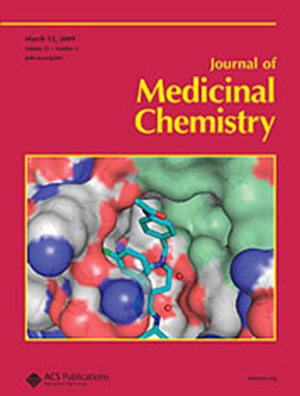Pseudonatural Products for Chemical Biology and Drug Discovery.
IF 6.8
1区 医学
Q1 CHEMISTRY, MEDICINAL
引用次数: 0
Abstract
Natural product (NP) structures have provided invaluable inspiration for the discovery of bioactive compound discovery. In the pseudonatural product (PNP) concept unprecedented combinations of NP fragments combine the biological relevance of NPs with exploration of wider chemical space by fragment-based design. We describe the principles underlying the PNP design and discovery of selected PNPs with unexpected or novel bioactivity. Cheminformatic analyses of ChEMBL 32, the Enamine screening library, phase 1-3 clinical compounds, and approved drugs reveal that ca. 1/3 of historically developed biologically active compounds and of currently commercially available screening compounds are PNPs, and that PNPs are increasing over time. PNPs are 54% more likely to be found in clinical compounds versus nonclinical compounds, and 67% of recent clinical compounds are PNPs. 63% of the core scaffolds in recent clinical compounds are made up of just 176 NP fragments, which suggests that PNPs open up a multitude of unexploited opportunities for drug discovery.用于化学生物学和药物发现的伪天然产物。
天然产物(NP)结构为生物活性化合物的发现提供了宝贵的灵感。在伪天然产物(PNP)概念中,前所未有的NP片段组合将NPs的生物学相关性与基于片段的设计探索更广泛的化学空间相结合。我们描述了PNP设计的基本原理,并发现了具有意想不到或新颖生物活性的选定PNP。ChEMBL 32、Enamine筛选文库、1-3期临床化合物和已批准药物的化学信息学分析表明,历史上开发的生物活性化合物和目前市售的筛选化合物中约有1/3是PNPs,并且PNPs随着时间的推移而增加。临床化合物中发现PNPs的可能性比非临床化合物高54%,最近的临床化合物中有67%是PNPs。在最近的临床化合物中,63%的核心支架仅由176个NP片段组成,这表明pnp为药物发现开辟了大量未开发的机会。
本文章由计算机程序翻译,如有差异,请以英文原文为准。
求助全文
约1分钟内获得全文
求助全文
来源期刊

Journal of Medicinal Chemistry
医学-医药化学
CiteScore
4.00
自引率
11.00%
发文量
804
审稿时长
1.9 months
期刊介绍:
The Journal of Medicinal Chemistry is a prestigious biweekly peer-reviewed publication that focuses on the multifaceted field of medicinal chemistry. Since its inception in 1959 as the Journal of Medicinal and Pharmaceutical Chemistry, it has evolved to become a cornerstone in the dissemination of research findings related to the design, synthesis, and development of therapeutic agents.
The Journal of Medicinal Chemistry is recognized for its significant impact in the scientific community, as evidenced by its 2022 impact factor of 7.3. This metric reflects the journal's influence and the importance of its content in shaping the future of drug discovery and development. The journal serves as a vital resource for chemists, pharmacologists, and other researchers interested in the molecular mechanisms of drug action and the optimization of therapeutic compounds.
 求助内容:
求助内容: 应助结果提醒方式:
应助结果提醒方式:


